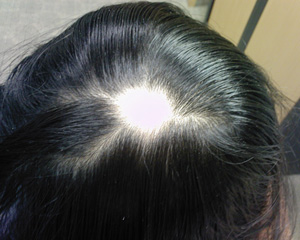Hair Loss
A woman’s self-worth is generally linked to her physical appearance and any change in the volume and texture of scalp hair has a significant impact on it. 50% of hair loss can occur before it becomes apparent, so subjective complaints should not be taken lightly by physicians.1 Women presenting with diffuse hair loss is a very common and challenging problem for dermatologists.
The hair follicle is a dynamic structure, responsible for creating and expelling the hair shaft. Hair follicular growth cycle occurs in 3 phases: anagen (growth phase), catagen (involutionary phase), and telogen (resting phase).2 Hair loss usually occurs a result of disruption of the hair follicle cycle.
In general, hair loss in women can be is classified as localised or diffuse based on the extent of hair loss.
|
HAIR LOSS IN WOMEN |
|
| DIFFUSE | LOCALISED |
| Telogen Effluvium | Alopecia Areata |
| Chronic Telogen effluvium | Traction alopecia |
| Female pattern hair loss | Tinea capitis |
| Miscellaneous : anagen effluvium, diffuse alopecia areata, congenital abnormalities | Lupus erythematosus |
Diffuse hair loss
The most common causes are Telogen effluvium (TE) , followed by female pattern hair loss (FPHL) and chronic telogen effluvium (CTE).3 Various other causes are not so common and can be diagnosed by examination and appropriate investigations
Telogen Effluvium (TE)
 Increased amounts of hair shedding in the telogen phase is referred to as Telogen effluvium. Telogen Effluvium is characterized by an abrupt onset of diffuse excessive shedding of normal club hairs, usually seen 2-3 months after a triggering event. The most common triggering factors are severe illnessess , postpartum, accidental trauma, major surgery, emotional stress, chronic systemic illness, large hemorrhage, and dietary weight loss programs .3 In about one third of the cases the cause remains elusive.
Increased amounts of hair shedding in the telogen phase is referred to as Telogen effluvium. Telogen Effluvium is characterized by an abrupt onset of diffuse excessive shedding of normal club hairs, usually seen 2-3 months after a triggering event. The most common triggering factors are severe illnessess , postpartum, accidental trauma, major surgery, emotional stress, chronic systemic illness, large hemorrhage, and dietary weight loss programs .3 In about one third of the cases the cause remains elusive.
Classical Telogen Effluvium is usually an acute process which is self limiting lasting for about 3-6 months.
In contrast, Chronic Telogen Effluvium (CTE) occurs when the stimulus that causes hair shedding persists beyond six months and the condition can become chronic . This condition may be primary or it may be secondary to some underlying disease and is also called as Chronic diffuse hair loss.4The most common causes of Chronic telogen Effluvium are Iron deficiency anemia, hypothyroidism , hyperthyroidism, malnutrition, acrodermatitis enteropathica, and acquired zinc deficiency .
Female Pattern Hair Loss (FPHL)
Female pattern hair loss is a type of hair loss which is due to a progressive reduction of hair cycle time , believed to be mediated through interaction between androgens and their receptors .5 FPHL is a gradual onset, slowly progressive non scarring alopecia, which can be seen any time after menarche, but is most common in females aged 20-40 years. Androgens definitely play a role in the pathogenesis of the androgenetic alopecia in males, but their role in female alopecia is less certain .
Localised hair loss
Alopecia areata
 This disorder believed to be auto immune , is characterized by localised patches of hair loss which appear as smooth bald patches. There is no itching and no scaling . The progress and prognosis depend on the severity of the auto immune process.
This disorder believed to be auto immune , is characterized by localised patches of hair loss which appear as smooth bald patches. There is no itching and no scaling . The progress and prognosis depend on the severity of the auto immune process.
Traction alopecia
Usually seen in the forehead and sides of the scalp and is due to the traction caused by the hair style , that is by pulling the hair tightly backwards .
Tine Capitis
This is a ringworm fungal infection of the scalp which is very itchy . The condition is diagnosed by the broken hairs in the hair loss patch and the inflammatory scaling.
Certain auto immune disorders such as Systemic lupus erythematosus and Discoid lupus erythematosus also cause localised hair loss.
Evaluation and Diagnosis
When evaluating hair loss in the clinical setting, the clinician should take a complete individual and family history. Androgenetic alopecia usually occurs in families.
Individual history should differentiate between assess hair loss versus hair thinning, duration of condition, and personal grooming practices. Since hair loss can be an early clinical sign of systemic disease, history should also include trauma, traction and a reaction to chemicals and medications.
Appropriate investigations may help in identifying aetiological factors .
Iron defiency anemias , hypothyroidism , Tinea capitis and autoimmune diseases can be detected by lab investigations .Treatment plans addressing the aetiology can help in the management of this distressing problem . It would alleviate the psychological stress associated with it , which can make the problem worse if not addressed.
Dermatologists in consult a wide range of patients with hair loss of different aetiologies in women .About 75 – 100 female patients are seen every month in the department for hair loss. Many women blame environmental factors such as water and soaps as the reason for their hair fall. Some women undergo frequent cosmetic hair treatments which alter the hair structure resulting in breakage. Understanding the cause of the hair loss is important in evaluating hair loss in women and helping them to comply with the expected course and treatment. An evaluative approach will identify the aetiology ,reveal underlying medical conditions ,predisposing factors and direct the clinicians towards the correct diagnosis and the appropriate plan of management and thereby ensure patient compliance and satisfaction .
References
- http://guidelines.gov/content.aspx?id=16324 .National Guideline clearing house / University of Austin, Texas. Evaluation of hair loss in adult women
- D.A.R.de Berber, Disorders of hair. In: Tony Burns,Stephen Breathnach, Neil Cox, Christopher Griffiths ,editors. Rook’s textbook of Dermatology,7th ed, Blackwell ,2004.pg 63.9-63.14
- Shrivastava SB .Diffuse hair loss in adult female:Approach to diagnosis and management.Indian J Dermatol Venereol Leprol 2009,75:20 -28
- Sinclair R. Diffuse hair loss. Int J Dermatol 1999;38:8-18
Sawaya MF, Price VH. Different levels of 5a- reductase type I and type II, aromatase, and androgen receptor in hair follicles of women and men with androgenetic alopecia. J Invest Dermatol 1997;109:296-300.
 Dr.Irene Nirmala Thomas
Dr.Irene Nirmala Thomas
Clinical Professor – Dept of Dermatology
GMC Hospital, Ajman

